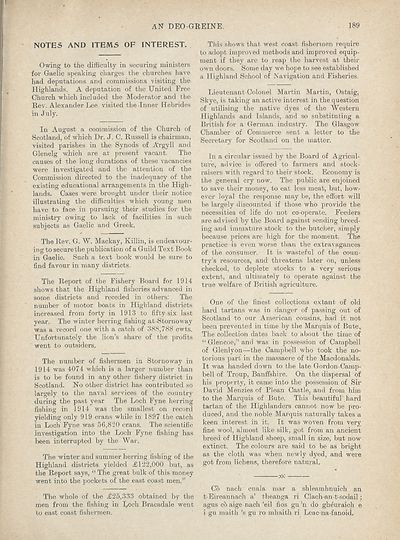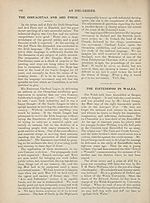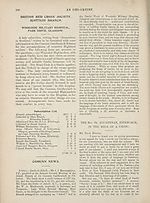An Comunn Gàidhealach Publications > Deo-gréine > Volume 10, October 1914-September 1915
(197) Page 189
Download files
Complete book:
Individual page:
Thumbnail gallery: Grid view | List view

AN DEO-GREINE.
189
NOTES AND ITEMS OF INTEREST.
Owing to the difficulty in securing ministers
for Gaelic speaking charges the churches have
had deputations and commissions visiting the
Highlands. A deputation of the United Free
Church which included the Moderator and the
Rev. Alexander Lee: visited the-Inner Hebrides
in July.
In August a commission of the Church of
Scotland, of which Dr. J. C. Russell is chairman,
visited parishes in the Synods of Argyll and
Glenelg which are at present vacant. The
causes of the long durations of these vacancies
were investigated and the attention of the
Commission directed to the inadequacy of the
existing educational arrangements in the High¬
lands. Cases were brought under their notice
illustrating the difficulties which young men
have to face in pursuing their studies for the
ministry owing to lack of facilities in such
subjects as Gaelic and Greek.
The Rev. G. W. Mackay, Killin, is endeavour¬
ing to secure the publication of a Guild Text Book
in Gaelic. Such a text book would be sure to
find favour in many districts.
The Report of the Fishery Board for 1914
shows that the Highland fisheries advanced in
some districts and receded in others: The
number of motor boats in HigWand districts
increased from forty in 1913 to fifty six last
year. The winter herring fishing at-Stornoway
was a record one with a catch of 388,788 cwts.
Unfortunately the lion’s share of the profits
went to outsiders.
The number of fishermen in Stornoway in
1914 was 4074 which is a larger number than
is to be found in any other fishery district in
Scotland. No other district has contributed so
largely to the naval services of the country
during the past year The Loch Fyne herring
fishing in 1914 was the smallest on record
yielding only 919 crans while in 1897 the catch
in Loch Fyne was 56,820 crans. The scientific
investigation into the Loch Fyne fishing has
been interrupted by the War.
The winter and summer herring fishing of the
Highland districts yielded £122,000 but, as
the Report says, “ The great bulk of this money
went into the pockets of the east coast men.”
The whole of the £25,333 obtained by the
men from the fishing in I^och Bracadale went
to east coast fishermen.
This shows that west coast fishermen require
to adopt improved methods and improved equip¬
ment if they are to reap the harvest at their
own doors. Some day we hope to see established
a Highland School of Navigation and Fisheries.
Lieutenant-Colonel Martin Martin, Ostaig,
Skye, is taking an active interest in the question
of utilising the native dyes of the Western
Highlands and Islands, and so substituting a
British for a German industry. The Glasgow
Chamber of Commerce sent a letter to the
Secretary for Scotland on the matter.
In a circular issued by the Board of Agricul¬
ture, advice is offered to farmers and stock-
raisers with regard to their stock. Economy is
the general cry now. The public are enjoined
to save their money, to eat less meat, but, how¬
ever loyal the response may be, the effort will
be largely discounted if those who provide the
necessities of life do not co-operate. Feeders
are advised by the Board against sending breed¬
ing and immature stock to the butcher, simply
because prices are high for the moment. The
practice is even worse than the extravagances
of the consumer. It is wasteful of the coun¬
try’s resources, and threatens later on, unless
checked, to deplete stocks to a very serious
extent, and ultimately to operate against the
true welfare of British agriculture.
One of the finest collections extant of old
hard tartans was in danger of passing out of
Scotland to our American cousins, had it not
been prevented in time by the Marquis of Bute*
The collection dates back to about the time of
“ Glencoe,” and was in possession of Campbell
of Glenlyon—the Campbell who took the no¬
torious part in the massacre of the Macdonalds.
It was handed down to the late Gordon-Camp-
bell of Troup, Banffshire. On the dispersal of
his property, it came into the possession of Sir
David Menzies of Plean Castle, and from him
to the Marquis of Bute. This beautiful hard
tartan of the Highlanders cannot how be pro¬
duced, and the noble Marquis naturally takes a
keen interest in it. It was woven from very
fine wool, almost like silk, got from an ancient
breed of Highland sheep, small in size, but now
extinct. The colours are said to be as bright
as the cloth was when newly dyed, and were
got from lichens, therefore natural.
C5 nach cuala mar a shleamhnuich an
t-Eireannach a’ theanga ri Clach-an-t-sodail;
agus cb aige nach ’eil fios gu ’n do gheuraich e
i gu maith’s gu ro mhaith ri Leac-na-fanoid.
189
NOTES AND ITEMS OF INTEREST.
Owing to the difficulty in securing ministers
for Gaelic speaking charges the churches have
had deputations and commissions visiting the
Highlands. A deputation of the United Free
Church which included the Moderator and the
Rev. Alexander Lee: visited the-Inner Hebrides
in July.
In August a commission of the Church of
Scotland, of which Dr. J. C. Russell is chairman,
visited parishes in the Synods of Argyll and
Glenelg which are at present vacant. The
causes of the long durations of these vacancies
were investigated and the attention of the
Commission directed to the inadequacy of the
existing educational arrangements in the High¬
lands. Cases were brought under their notice
illustrating the difficulties which young men
have to face in pursuing their studies for the
ministry owing to lack of facilities in such
subjects as Gaelic and Greek.
The Rev. G. W. Mackay, Killin, is endeavour¬
ing to secure the publication of a Guild Text Book
in Gaelic. Such a text book would be sure to
find favour in many districts.
The Report of the Fishery Board for 1914
shows that the Highland fisheries advanced in
some districts and receded in others: The
number of motor boats in HigWand districts
increased from forty in 1913 to fifty six last
year. The winter herring fishing at-Stornoway
was a record one with a catch of 388,788 cwts.
Unfortunately the lion’s share of the profits
went to outsiders.
The number of fishermen in Stornoway in
1914 was 4074 which is a larger number than
is to be found in any other fishery district in
Scotland. No other district has contributed so
largely to the naval services of the country
during the past year The Loch Fyne herring
fishing in 1914 was the smallest on record
yielding only 919 crans while in 1897 the catch
in Loch Fyne was 56,820 crans. The scientific
investigation into the Loch Fyne fishing has
been interrupted by the War.
The winter and summer herring fishing of the
Highland districts yielded £122,000 but, as
the Report says, “ The great bulk of this money
went into the pockets of the east coast men.”
The whole of the £25,333 obtained by the
men from the fishing in I^och Bracadale went
to east coast fishermen.
This shows that west coast fishermen require
to adopt improved methods and improved equip¬
ment if they are to reap the harvest at their
own doors. Some day we hope to see established
a Highland School of Navigation and Fisheries.
Lieutenant-Colonel Martin Martin, Ostaig,
Skye, is taking an active interest in the question
of utilising the native dyes of the Western
Highlands and Islands, and so substituting a
British for a German industry. The Glasgow
Chamber of Commerce sent a letter to the
Secretary for Scotland on the matter.
In a circular issued by the Board of Agricul¬
ture, advice is offered to farmers and stock-
raisers with regard to their stock. Economy is
the general cry now. The public are enjoined
to save their money, to eat less meat, but, how¬
ever loyal the response may be, the effort will
be largely discounted if those who provide the
necessities of life do not co-operate. Feeders
are advised by the Board against sending breed¬
ing and immature stock to the butcher, simply
because prices are high for the moment. The
practice is even worse than the extravagances
of the consumer. It is wasteful of the coun¬
try’s resources, and threatens later on, unless
checked, to deplete stocks to a very serious
extent, and ultimately to operate against the
true welfare of British agriculture.
One of the finest collections extant of old
hard tartans was in danger of passing out of
Scotland to our American cousins, had it not
been prevented in time by the Marquis of Bute*
The collection dates back to about the time of
“ Glencoe,” and was in possession of Campbell
of Glenlyon—the Campbell who took the no¬
torious part in the massacre of the Macdonalds.
It was handed down to the late Gordon-Camp-
bell of Troup, Banffshire. On the dispersal of
his property, it came into the possession of Sir
David Menzies of Plean Castle, and from him
to the Marquis of Bute. This beautiful hard
tartan of the Highlanders cannot how be pro¬
duced, and the noble Marquis naturally takes a
keen interest in it. It was woven from very
fine wool, almost like silk, got from an ancient
breed of Highland sheep, small in size, but now
extinct. The colours are said to be as bright
as the cloth was when newly dyed, and were
got from lichens, therefore natural.
C5 nach cuala mar a shleamhnuich an
t-Eireannach a’ theanga ri Clach-an-t-sodail;
agus cb aige nach ’eil fios gu ’n do gheuraich e
i gu maith’s gu ro mhaith ri Leac-na-fanoid.
Set display mode to:
![]() Universal Viewer |
Universal Viewer | ![]() Mirador |
Large image | Transcription
Mirador |
Large image | Transcription
| An Comunn Gàidhealach > An Comunn Gàidhealach Publications > Deo-gréine > Volume 10, October 1914-September 1915 > (197) Page 189 |
|---|
| Permanent URL | https://digital.nls.uk/125241828 |
|---|
| Description | Leabhar 10, Mìos Deireannach an Fhogharaidh 1914 gu Darna Mìos an Fhogharaidh 1915 |
|---|---|
| Attribution and copyright: |
|
| Description | This contains items published by An Comunn, which are not specifically Mòd-related. It includes journals, annual reports and corporate documents, policy statements, educational resources and published plays and literature. It is arranged alphabetically by title. |
|---|
| Description | A collection of over 400 items published by An Comunn Gàidhealach, the organisation which promotes Gaelic language and culture and organises the Royal National Mòd. Dating from 1891 up to the present day, the collection includes journals and newspapers, annual reports, educational materials, national Mòd programmes, published Mòd literature and music. |
|---|---|
| Additional NLS resources: |
|

